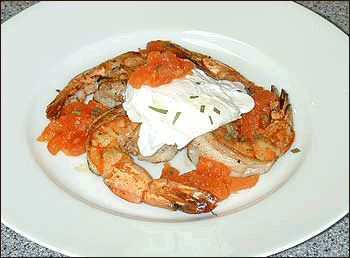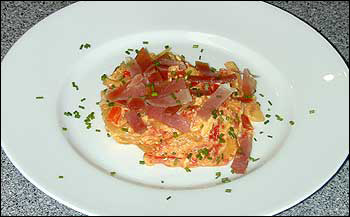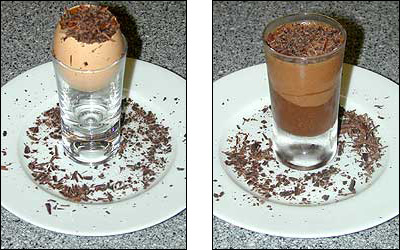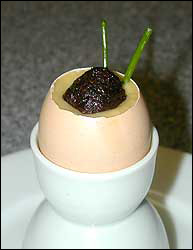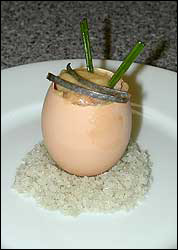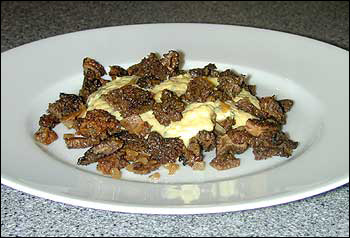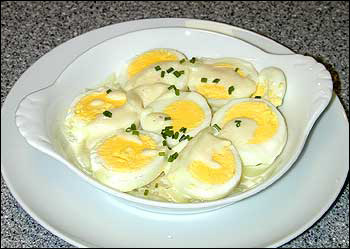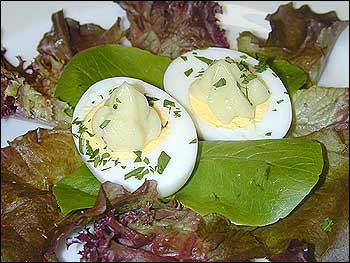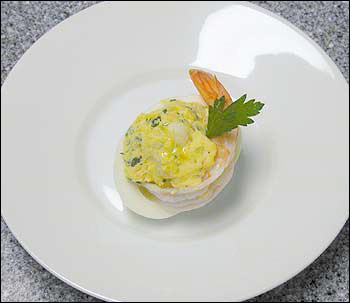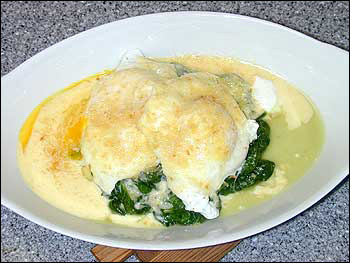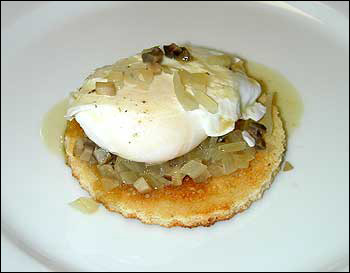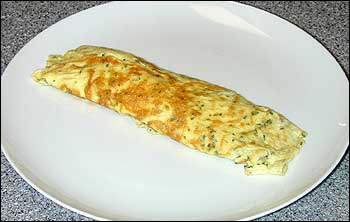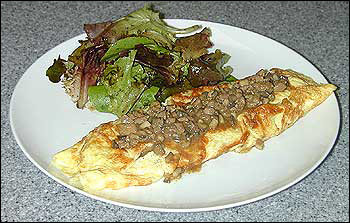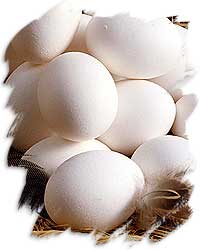 Œufs, eggs in English, are ubiquitous in French cooking. Not only as a supporting player, but also as the star performer. In a country that has traditionally eaten a light breakfast, eggs make their appearance during lunch and dinner. Where Americans think of eggs mostly as a breakfast item, the French welcome them in a multitude of forms as part of l’entrée, the starter, or le plat, the main course.
Œufs, eggs in English, are ubiquitous in French cooking. Not only as a supporting player, but also as the star performer. In a country that has traditionally eaten a light breakfast, eggs make their appearance during lunch and dinner. Where Americans think of eggs mostly as a breakfast item, the French welcome them in a multitude of forms as part of l’entrée, the starter, or le plat, the main course.
In his 1914 classic, Le Répertoire de la Cuisine, Louis Saulnier lists 422 different egg dishes. But those are only the recipes where eggs star. There are many more recipes where eggs are a significant ingredient, such as soufflés and custards. Many of Saulnier’s recipes are exact duplicates of those detailed by Escoffier in Le Guide Culinaire, originally published in 1902. (Saulnier’s goal was to create a compendium, “a brief and handy form, [of] as many recipes as possible, both old and new, with which every skilled cook should be familiar.”) Escoffier also lists a very large number of egg recipes in his book.
Both Saulnier and Escoffier list ten basic ways of cooking eggs, some of which are familiar to the American diner. The descriptions below are quoted from Saulnier.
- Brouillés [scrambled]
- [Put the] eggs in a pan with salt, pepper; whisk and cook them in bain-marie. Finish with cream and butter.
- En cocotte [coddled]
- Butter the cocotte and break the eggs in, season and place them in a pan or tin with water, steam under cover, or bake in oven.
- Durs [hard-boiled]
- Place the eggs in boiling water and cook 8 minutes, plunge in cold water.
- Frits [fried]
- Break the egg on a plate, season with salt and pepper, heat some oil in an omelet pan, let the egg slide into the oil and with a wooden spoon cover up the yolk with the solidified portions of the white, one egg at a time.
- Coque (à la) [soft-boiled]
- Plunge the egg in boiling water and cook two or three minutes.
- Mollets [soft-boiled]
- Boil five and half minutes, cool and shell.
- Moulés [coddled]
- Break the eggs in butter moulds, cook five and half minutes, let stand a while and unmold.
- Pochés [poached]
- Break the eggs in boiling water and poach two minutes and a half, when done dip them in cold water.
- Omelettes [omelets]
- Omelet making is at once very simple and very difficult, for tastes differ regarding their preparation. Some like them well done, some just done, and other almost liquid. The eggs are beaten, seasoned and poured in an omelet-pan containing very hot butter, stir briskly with a fork in order to heat the whole evenly, and if the omelet is to be garnished it should be done before rolling up. The whole process should be done speedily, and requires long practice to attain perfection.
- Œufs sur le plat [baked]
- Butter the egg dish, season the bottom and break the egg in, start cooking on the stove and finish in the oven, in a tin containing water.
Saulnier’s times are a bit shorter than commonly used for modern preparation. Escoffier’s timings are closer to those used today. Probably, eggs in their time were a bit different from the factory eggs available to today’s cooks.
French eggs are also sized differently from those in the U.S. In both countries, the standard size used in recipes is a “large” egg. The average net weight of an American large egg is 50 grams (30 grams of white and 20 grams of yolk), whereas in the EU, a large egg is closer to 58 grams. My experience with French eggs is that they tend to have a slightly thicker and tougher shell than American eggs. This makes them stronger as a “serving container.”

For the recipe selection presented below, I’ve chosen both traditional and modern egg recipes. I’ve also tried to present a cross-section of preparation styles and courses. Click on a recipe title to open the recipe.
Other egg recipes previously published on this web site:


©2000, 2014 Peter Hertzmann. All rights reserved.
This dish was originally titled langoustines à l’œuf poché et au vinaigre d’estragon. Since langoustines, Dublin Bay prawns, are not generally available in my part of the world, large shrimp have been substituted. Be careful not to overcook the shrimp or they will become tough. I remove the shrimp from the pan when their interior temperature reaches 105 to 110 °F (41 to 43 °C).
gambas à l’œuf poché et au vinaigre d’estragon
(jumbo shrimp with an egg poached in tarragon vinegar)
300 g (11 oz) large (16‑20 count)
shrimp
2 small
shallots, finely diced
200 g (7 oz)
tomatoes, peeled, seeded, diced
2 sprigs
fresh tarragon, minced
salt and freshly ground black pepper
2 splashes
distilled vinegar
1. Peel the shrimp leaving the tail and last section of shell intact. Make a shallow cut down the back of the shrimp and remove vein. Set aside.
2. Melt 1 T butter in a saucepan over medium heat. Sweat the shallots until soft. Add tomatoes, lower heat, and cook until the juices released have evaporated. Add white wine and red wine vinegar and reduce again. Whisk in 1 tablespoon butter and half of the tarragon. Adjust seasonings. Set aside and keep warm.
3. Fill a saucepan three‑fourths full with water and bring to a boil. Add tarragon vinegar and reduce heat so that water is just below a boil. One at a time, break eggs into a small bowl and slip gently into water. Poach until the whites appear cooked, but the yolks are still liquid, about 3 minutes. Drain on absorbent paper.
4. In the meantime, heat a large frying pan over high heat. Add the last tablespoon of butter and the olive oil and heat. Add shrimp and cook. Remove and drain on absorbent paper.
5. Arrange shrimp on warmed serving plates. Top with tomato sauce and finally a poached egg. Garnish with the remaining fresh tarragon. Serve immediately.
Yield: 2 servings.
Ref: Georges Blanc, Ma Cuisine des Saisons, 1987, page 193.

©2000, 2014 Peter Hertzmann. All rights reserved.
In this unusual fruit salad, each bite is perfumed by the hint of lemongrass. The subtle, lemon flavor is carried over into the meringues. The meringues require a large pan of water, but will shrink substantially as they cook. Just about any combination of ripe, summer fruits will work for this preparation. In the picture below, strawberries, black figs, white peaches, and blueberries were used. The original recipe called for fresh apricots, but these were unavailable when this recipe was prepared, so dried ones were substituted.
île flottante citronnée aux fruits d’été
(lemon-flavored floating islands with summer fruit)
1 branch
lemongrass, trimmed
200 g (1 c)
granulated sugar
100 g (31⁄2 oz)
fresh or dried apricots
800 g (13⁄4 lb)
summer fruits, bite‑size pieces
60 g (1⁄3 c)
finely granulated sugar
1. Cut lemongrass lengthwise a number of times, but leave the last inch of the root end uncut. Fold in half and add to a saucepan with water and sugar. Boil for 2 to 3 minutes. Add apricots and continue cooking for 5 minutes more. Remove lemongrass and discard. Puree mixture in a blender. Set aside to cool.
2. Add fruit to syrup and macerate for a couple of hours.
3. Beat egg whites with a whisk until soft peaks are formed. Add sugar and lemon juice and continue beating until firm peaks are formed. Bring a wide pan of water to a low simmer. Using 2 spoons, dipped in warm water, form 8 quenelles of the egg whites. Cook gently for 3 minutes on each side. Drain on absorbent paper.
4. Divide fruit among serving bowls. Place 2 quenelles on each bowl and serve.
Yield: 4 servings.
Ref: Laurent Duchéne, Cuisiner!, August 1997, page 27.

©2000, 2014 Peter Hertzmann. All rights reserved.
The original recipe for this dish, a translation and adaptation from the French original, called for less cooking of the peppers, which left them essentially raw. Furthermore the picture accompanying the recipe showed an egg dish that had been cooked in an oven like a fritata. The method presented below is similar to what has been found in a number of French cookbooks. The Basque-style ham traditional for this dish is not generally available in the U.S. so another dried, cured ham has been substituted. Also, the ham is normally served as a full slice instead of julienned, as stated in the recipe below.
œufs à la piperade
(eggs with onions, peppers, and tomatoes)
1 medium
onion, julienned
1 clove
garlic, thinly sliced
150 g (1⁄3 lb)
green bell pepper, julienned
340 g (3⁄4 lb)
plum tomatoes, peeled, seeded, cored, julienned
3 extra‑large
eggs, beaten
salt and freshly ground black pepper
2 thin slices
prosciutto, julienned
1. Heat oil in a large nonstick frying pan over medium‑low heat. Add onion, garlic, and pepper and fry for 15 minutes. Lower heat and add tomatoes. Continue to fry for another 10 minutes. The peppers and onion should be tender and sweet; the tomatoes should be very soft.
2. Add the eggs and stir with a rubber spatula until small curds form. Adjust seasonings. Divide between heated serving plates and arrange prosciutto on top. Garnish with chives.
Yield: 2 serving.
Ref: Paul Bocuse, Paul Bocuse’s Regional French Cooking, 1997, page 104.

©2000, 2014 Peter Hertzmann. All rights reserved.
Because the eggs are not cooked in this recipe, it is very important that they be absolutely fresh. Although, two separate chocolate mixtures are prepared, both are made very fast. The longest step for this recipe is washing all the little bowls used in the preparation. The final portion size is small, but the results are quite rich and only a masochist would ask for seconds!
œufs aux deux chocolats
(eggs with two chocolates)
30 g (1 oz)
dark chocolate
30 g (1 oz)
milk chocolate
1. If the egg shells are going to be used for serving the finished dessert, carefully remove the tops of each egg. Separate the whites from the yolks. Wash out the shell and remove the loose membrane. Boil the shells for a few minutes and then dry carefully. Chill before filling.
2. Beat the egg whites with the salt until firm. Separate into two bowls and set aside.
3. Melt the dark chocolate in a double boiler until about two‑thirds melted. Remove from heat and continue stirring until the chocolate is melted. Add 1 egg yolk and mix thoroughly. Whisk in one of the egg white portions and place in the refrigerator until needed.
4. Repeat the same process with the milk chocolate.
5. Pour the dark chocolate mixture into the egg shells or small cups. Level the surface and pour in the milk chocolate mixture. Set in the refrigerator for a couple of hours before serving.
6. Decorate with chocolate shavings or other garnish when serving.
Yield: 2 servings.
Ref: Bernard Loiseau, Les Dimanches de Bernard Loiseau, 1995, page 42.

©2000, 2014 Peter Hertzmann. All rights reserved.
Scrambled eggs in France are definitely different from their American cousin. In France, they are moist with a consistency similar to pudding. In the United States they are drier and firm. In the recipe below, the French manner is preferred, but they also can be prepared with a small, moist curd if that is preferred. If the eggs are to be served in egg shells, wash the shells with plain water, boil for a couple of minutes, and dry carefully before using.
œufs brouillés à la tapenade
(scrambled eggs with tapenade)
3 extra‑large
eggs, lightly beaten
tapenade:
110 g (1⁄4 lb)
black olives, pitted
25 g (1 oz)
anchovy fillets
1 small clove
garlic, smashed
4 large leaves
fresh basil
2 T
extra‑virgin olive oil
1. Place the tapenade ingredients in the bowl of a small food processor and process until blended and homogenous. Set aside.
2. Melt 30 g (2 T) butter in a double‑boiler over high heat. Add the eggs and stir continuously with a whisk until they thicken like pudding. If curds start to form, remove from heat for a while. When thick, add the remaining butter and continue stirring until melted and blended. Taste for salt.
3. Serve eggs in small bowls, or empty egg shells, with ½ teaspoon of tapenade on top of each serving.
Note: This recipe will yield about 110 ml (½ c) tapenade, much more than needed for this recipe.
Yield: 2 servings.
Ref: concept and tapenade from Georges Blanc, Ma Cuisine des Saisons, 1987, page 31. Egg method from Paul Bocuse, La Cuisine de Marché, 1998, page 81.

©2000, 2014 Peter Hertzmann. All rights reserved.
This preparation is a great way to use up a few scraps of smoked salmon. The salmon should be added at the last minute before serving so it doesn’t cook further. When I originally had this preparation, it was served as part of a Sunday brunch in soup bowls. The quantity presented below is more appropriate for a simple amuse-bouche.
œufs brouillés au saumon fumé
(scrambled eggs with smoked salmon)
2 extra‑large
eggs, lightly beaten
2 T
smoked salmon, broken into small pieces
1. Melt 20 g (4 t) butter in a double‑boiler over medium heat. Add the eggs and stir continuously with a whisk until they thicken like pudding. If curds start to form, remove from heat for a while. When thick, add the remaining butter and continue stirring until melted and blended. Taste for salt.
2. Add salmon and chives to eggs and serve in small bowls, or empty egg shells.
Yield: 2 servings.
Ref: concept from Frédéric Médigue, Le Château d’Amondans, Amondans, France, May 2000. Egg method from Paul Bocuse, La Cuisine de Marché, 1998, page 81.

©2000, 2014 Peter Hertzmann. All rights reserved.
This is a very simple recipe that, with a little planning, can be made and assembled in a few minutes. If you are lucky enough to have fresh morel mushrooms available, use these instead of the dried listed in the ingredients list. It will take 125 grams (a little more than 1/4 pound) of fresh morels to have an amount equivalent to the dried mushrooms listed. The chives are my addition to the recipe — I like chives with scrambled eggs.
œufs brouillés aux morilles
(scrambled eggs with morel mushrooms)
1 small
shallot, finely diced
25 to 35 g (about 1+ oz)
dried morel mushrooms, reconstituted, cut into small pieces, well drained
50 ml (31⁄3 T)
veal stock
salt and freshly ground black pepper
5 extra‑large
eggs, beaten
2 T
minced chives [optional]
1. Melt 1 T butter in a large frying pan over medium heat. Add the shallots and sweat. Add mushrooms and stock, and continue cooking for about 5 minutes. When cooked, season with salt and pepper. Set aside and keep warm.
2. Melt 1 T of butter in a double‑boiler over medium heat. Add the eggs and stir continuously with a whisk until they thicken with small curds. If curds start to form too fast, remove the pan from the heat for a while. When thick, add the remaining tablespoon of butter and continue stirring until melted and blended. Taste for salt and pepper. Add the chives [optional].
3. Divide the morels among warmed serving plates. Top the morels with the eggs and serve.
Yield: 2 servings.
Ref: Bernard Loiseau, Cuisine en Famille, 1997, page 74.

©2000, 2014 Peter Hertzmann. All rights reserved.
This recipe can be found in a number of traditional French cookbooks. The consensus seems to be that the name comes from the appearance of the final dish since it does not contain tripe as an ingredient. This dish has to be prepared just before serving so eggs still taste fresh.
œufs durs aux oignons dits à la tripe
(hard-cooked eggs and onions with bechamel sauce)
1 medium
onion, julienned
pinch
freshly ground white pepper
160 ml (2⁄3 c)
whole milk
1. Melt 1 T butter in a saucepan over medium heat. Add onions, lower heat, and sweat for 15 minutes until soft. Do not brown the onions.
2. Add flour and mix thoroughly. Add salt, pepper, and nutmeg and mix. Add milk and mix until flour is dissolved. Bring to a boil and then lower heat to simmer. Cover and simmer for 20 minutes.
3. In the meantime, cover eggs with water in a saucepan and bring to a boil. Cook the eggs over a low boil for 9 minutes.
4. Add remaining tablespoon of butter to the sauce and stir until combined. Using a slotted spoon, divide the onions among warm serving plates. Peel the warm eggs, slice into 6‑mm (1⁄4‑in) slices, and arrange on the onions. Divide the remaining sauce over the eggs.
5. Optional, garnish with minced chives.
Yield: 2 servings.
Ref: Paul Bocuse, La Cuisine de Marché, 1998, page 54.

©2000, 2014 Peter Hertzmann. All rights reserved.
This is a traditional, inexpensive bistro first course. If you can boil an egg, this recipe is simple! Be sure the eggs are very cold before cutting them in half.
œufs durs mayonnaise
(hard-cooked eggs with fresh mayonnaise)
2 extra‑large
cold, hard‑cooked eggs
mayonnaise:
fine salt and freshly ground white pepper
250 ml (1 c)
sunflower seed oil
1. Prepare mayonnaise: Mix the egg yolk, mustard, vinegar, salt, and pepper together with a whisk. Slowly whisk in the oil, starting with just a few drops until it is completely emulsified. Set aside.
2. Arrange the salad greens on serving plates. If desired mix the greens with a light vinaigrette first. Cut each egg in half lengthwise, and place two halves on each plate. Top each half with some mayonnaise. Garnish with parsley.
Note: This recipe makes enough mayonnaise for 15 to 25 portions, depending on how much is used for each portion.
Yield: 2 servings.
Ref: Linda Dannemberg, Paris Bistro Cooking, 1991, page 62.

©2000, 2014 Peter Hertzmann. All rights reserved.
If you’re the type of person who loves American-style deviled eggs, this recipe is probably not for you. The flavors of this amuse-bouche are far more subtle than its American cousin. The yolk mixture can be prepared ahead of time, but the eggs should be stuffed at the last minute so the yolk mixture does not dry out on the surface.
œufs mimosa aux crevettes
(shrimp-stuffed eggs)
3 medium (about 35 g [1+ oz])
shrimp
1 large
egg, hard‑cooked, chilled
1 sprig
chive, finely minced
4 leaves
parsley, finely minced
fine salt and freshly ground white pepper
1. Peel the shrimp, except for the last segment of shell near the tail. Make a shallow cut down the back of the shrimp and remove the vein. Poach in boiling water for 30 seconds. Chill in cold water. Remove the last shell segment of 2 of the shrimp, leaving the tail shell intact, and set aside in the refrigerator until needed. Completely peel the remaining shrimp and mince.
2. Cut the egg in half lengthwise. Set the whites aside. Crush the yolk completely with a fork and combine with minced shrimp, mayonnaise, chive, and parsley. Season with salt and pepper.
3. Fill the egg white halves with the yolk mixture and garnish each with a whole cooked shrimp. Place on individual serving plates and drizzle a couple of drops of olive oil on each.
Yield: 2 servings.
Ref: Cuisine et Vins de France, July‑August 2000, page 44.

©2000, 2014 Peter Hertzmann. All rights reserved.
This is a classic French recipe. Although I found the recipe in Paul Bocuse’s epic tome on French cooking, there is a similar recipe in Escoffier’s Ma Cuisine, published in the 1930s. I would suspect that its history goes back long before then.
I’ve changed the cooking method for the spinach to one that I learned from a different French chef who was preparing a different recipe. The original recipe called for the spinach to be boiled, drained, chilled, squeezed, and then sautéed. I suspect this was because spinach used to be a lot tougher than it is today. Also, the original recipe called for the dish to be cooked in a hot oven. I feel the broiler does a better job of browning the topping without cooking the eggs too much.
œufs pochés à la florentine
(poached eggs and spinach)
340 g (3⁄4 lb)
fresh spinach, well‑cleaned, leaves only
salt and freshly ground black pepper
20 g (2⁄3 oz)
fresh bread crumbs
20 g (2⁄3 oz)
freshly grated dried Gruyère or Parmesan cheese
1 T
melted, unsalted butter
sauce Mornay:
250 mill (1 c)
whole milk
1 t
dehydrated veal stock
fine salt, freshly ground white pepper, and freshly ground nutmeg
25 g (scant 1 oz)
freshly grated Gruyère cheese
1. For sauce Mornay: melt 1 T butter in a saucepan over medium heat. Add the flour and cook for a while. Whisk in the milk, stock, and seasonings. Set over very low heat and cook for about 30 minutes.
2. Preheat broiler.
3. Fill a sauce pan three‑fourths full with water and bring to a boil. Add vinegar and reduce heat so that water is just below a boil. One at a time, break eggs into a small bowl and slip gently into water. Poach until the whites appear cooked, but the yolks are still liquid, about 21⁄2 minutes. Drain on absorbent paper.
4. While the eggs are poaching, add butter and oil to a large, deep frying pan over high heat. When butter has melted, add spinach. Salt and pepper to taste. Cover and cook until barely wilted. Stir a couple of times. Remove from heat and set aside, covered.
5. Divide spinach among serving plates. Carefully place 2 poached eggs on top of each portion of spinach. Whisk the cheese into the sauce. Whisk together the egg yolk and cream in a separate bowl. Slowly whisk the sauce into the egg mixture. Spoon some of the sauce over the poached eggs. Combine the bread crumbs and dried cheese and sprinkle over the eggs. Finally, sprinkle the melted butter over the bread crumbs.
6. Brown the bread crumbs lightly under the broiler for a couple of minutes. Serve immediately.
Note: The recipe makes enough sauce for 5 to 6 portions.
Yield: 2 servings.
Ref: Paul Bocuse, La Cuisine de Marché, 1998, page 52 (for sauce Mornay, page 99; for sauce béchamel, page 92).

©2000, 2014 Peter Hertzmann. All rights reserved.
The original recipe for this dish was called œufs pochés saumurois after the Saumur wine, a sparkling white wine from the Loire village of the same name, used in the preparation. The recipe is a variation of the traditional Burgundian preparation œufs en meurette. The original recipe also called for poaching the eggs in the sauce before reducing it, but this has two problems — first, there is not enough liquid when prepared in small portions to poach the eggs, and second, the eggs have to sit around for quite a while until the sauce is reduced.
œufs pochés au vin blanc
(poached eggs with mushrooms and white wine)
20 g (2⁄3 oz)
diced white mushrooms
45 g (11⁄2 oz)
diced onions
125 ml (1⁄2 c)
dry white wine
125 ml (1⁄2 c)
chicken stock
salt and freshly ground black pepper
2 slices
pain de mie, toasted
1. Melt 1 T butter in a small saucepan over low heat. Add mushrooms and onions and sweat until soft, about 10 minutes. Add wine, stock, and tarragon. Simmer for 10 minutes further.
2. Strain mushrooms and onions from sauce, adjust seasoning, and set aside. Keep warm. Discard tarragon sprig. Reduce sauce until it starts to thicken. Keep warm.
3. Fill a saucepan three‑fourths full with water and bring to a boil. Add vinegar and reduce heat so that water is just below a boil. One at a time, break eggs into a small bowl and slip gently into water. Poach until the whites appear cooked, but the yolks are still liquid, about 3 minutes. Drain on absorbent paper.
4. Using a fluted cutter, cut a large disk from the center of each piece of toast. Place each slice in the center of a heated serving plate. Divide the mushroom mixture among the toast disks. Place a poached egg on top of each disk. Finish sauce with 1 T of butter, adjust seasoning, and spoon over eggs.
Yield: 2 servings.
Ref: Hilaire Walden, Loire Gastronomique, 1993, page 111.

©2000, 2014 Peter Hertzmann. All rights reserved.
This is a very traditional omelet. Although there are only a few ingredients used in its preparation, the taste is actually quite sophisticated. The combination of herbs can be varied, but Escoffier advises: “It is absolutely incorrect to consider an omelet made only with parsley as an omelette aux fines herbes.”
omelette aux fines herbes
(herb omelet)
fine salt and freshly ground black pepper
1 T
minced herbs, a combination of parsley, chervil, tarragon, chives
1. Preheat oven to 75 °C (170 °F). Preheat the serving plate.
2. Melt butter in a large nonstick frying pan over high heat. While the butter is melting, lightly beat the eggs, salt and pepper, and herbs. Add the eggs to the melted butter. Using a spatula, scramble the eggs until two‑thirds cooked. Then spread the eggs evenly out across the bottom of the frying pan. Let the eggs fully set. Roll the omelet out onto a heated plate.
3. Serve immediately.
Yield: 1 serving.
Ref: Auguste Escoffier, Le Guide Culinaire, 1982 edition of translation of 1921 edition, page 176.

©2000, 2014 Peter Hertzmann. All rights reserved.
This is one of the traditional egg recipes in this web collection. Although I referenced Paul Bocuse in this recipe, I could have easily referenced Auguste Escoffier instead since he has essentially the same recipe in Le Guide Cuisine, written in 1902. One change that I’ve made to the recipe is to combine the garnish and the sauce instead of plating them separately. This makes the garnish more moist and taste better.
omelette chasseur
(hunter’s omelet with chicken livers and mushrooms)
2 or 3, about 90 g (3 oz),
chicken livers, cleaned very well, 6‑mm (1⁄4‑in) dice
fine salt and freshly ground black pepper
1 small
shallot, finely diced
4 medium
mushrooms, peeled, 6‑mm (1⁄4‑in) dice
1. Preheat oven to 75 °C (170 °F). Preheat the serving plate.
2. Heat 1 T butter in a small nonstick frying pan over high heat. When melted, season chicken livers and add to butter. Fry just until the livers stiffen; the meat should remain pink. Remove the livers from the pan with a slotted spoon. Drain in strainer in the oven.
3. Add the shallot and mushrooms to the frying pan and cook in the same butter left from the livers. Add an additional tablespoon of butter if necessary. Season with salt and pepper. When the mushrooms are soft, remove from the pan with a slotted spoon and add to the livers in the strainer.
4. Return the frying pan to the high heat and add the Madeira wine. Reduce by half. Add demi‑glace and juices drained from livers and mushrooms. Reduce again until a syrup‑like consistency is attained. Remove pan from heat and stir in 1 T butter. Combine with livers and mushrooms and keep warm.
5. Melt the last tablespoon of butter in a large nonstick frying pan over high heat. While the butter is melting, lightly beat the eggs and season with salt and pepper. Add the eggs to the melted butter. Using a spatula, scramble the eggs until two‑thirds cooked. Then spread the eggs evenly out across the bottom of the frying pan. When the bottom is cooked and the top still slightly liquid, garnish the center with two‑thirds of the liver mixture. Roll the omelet out onto a heated plate. Using the spatula, make a shallow cut down the center of the omelet. Spread the edges of the cut slightly and fill with the remaining chicken livers.
Yield: 1 serving.
Ref: Paul Bocuse, La Cuisine de Marché, 1998, page 59.

©2000, 2014 Peter Hertzmann. All rights reserved.
œufs pochés à la fondue d’oignons
(poached egg on a bed of caramelized onions)
2 large (about 450 g [1 lb])
yellow onions, shredded
fine salt and freshly ground black pepper
1⁄2 t
shredded truffle [optional]
1. Melt butter in a large saucepan over high heat. Stirring constantly, fry onions for 5 minutes. Reduce heat to low and continue cooking onions for 45 minutes until very soft and golden in color. Stir occasionally. Set aside, covered, in a warm oven.
2. Boil water for poached eggs. Add vinegar to acidify water.
3. Combine 1 T of the onions with the chicken stock and force through a fine sieve to create a fine puree. Season puree with salt and pepper. Warm puree over hot water, set aside, and keep warm.
4. Poach eggs for 3 minutes. Remove from water and drain on paper towels.
5. Divide onion mixture into 2 mounds on serving plates. Alternatively, use a 7‑cm (23⁄4‑in) ring to form onion mound on plates. Place a poached egg on each mound. Top with puree and decorate with truffle pieces.
Yield: 2 servings.
Ref: Bernard Loiseau, Cuisine en Famille, 1997, page 76.

©2000, 2014 Peter Hertzmann. All rights reserved.
salade de lentilles vertes du Puy aux œufs pochés
(lentil salad with a poached egg)
100 g (31⁄2 oz)
green lentils
1⁄2 small
yellow onion, tied with string
85 g (3 oz)
bacon, 6‑mm (1⁄4‑in) wide crosswise strips
1
spring onion, finely minced
1⁄2 T
minced flat‑leaf parsley
vinaigrette:
salt and freshly ground black pepper
1. Place lentils, carrot, bouquet garni, onion, and water in a saucepan and bring to a boil. Reduce heat, cover, and simmer for 20 to 25 minutes until the lentils are just tender. Remove and discard the carrot, bouquet garni, and onion. Salt the lentils and mix. Set aside.
2. Place bacon in a small saucepan and cover with cold water. Bring to a boil and drain well on paper towels. Set aside.
3. Prepare the vinaigrette.
4. Fill a saucepan three‑fourths full with water and bring to a boil. Add a splash of vinegar and reduce heat so that water is just below a boil. One at a time, break eggs into a small bowl and slip gently into water. Poach until the whites appear cooked, but the yolks are still liquid, about 3 minutes. Drain on paper towels.
5. Combine the lentils, spring onion, and vinaigrette. Divide lentil mixture on serving plates as flat‑top mounds. Sprinkle each mound with cooked bacon and parsley. Add a poached egg to each mound and serve immediately.
Yield: 2 servings.
Ref: Bernard Loiseau, Cuisine en Famille, 1997, page 65.

©2000, 2014 Peter Hertzmann. All rights reserved.
Macaroni salad may be as “American as apple pie,” but this version by Michelin three-star chef Bernard Loiseau definitely has a French accent. This version uses less mayonnaise than its American cousin, and it’s not as sweet either.
salade de pâtes au poulet et aux œufs durs à la mayonnaise
(macaroni salad with smoked chicken and hard-boiled eggs)
110 g (4 oz)
elbow macaroni, cooked, cooled, drained, mixed with a few drops of olive oil
175 g (6 oz)
smoked chicken, 5‑mm (3⁄16‑in) dice
3 sprigs
chives, 3‑mm (1⁄8‑in) long pieces
1
tomato, peeled, seeded, 5‑mm (3⁄16‑in) dice
3
hard cooked eggs, peeled, cut lengthwise into quarters
mayonnaise:
1⁄2 T
Dijon‑style mustard
salt and freshly ground black pepper
1. Whisk thoroughly together the egg yolk and mustard. Slowly whisk in olive oil. Add vinegar, salt and pepper.
2. Combine three‑fourths of the mayonnaise with the macaroni, half the chicken, and the chives. Divide on serving plates.
3. Combine the remaining mayonnaise with the remaining chicken and the diced tomato. Divide on top of macaroni.
4. Arrange 6 egg quarters in a star pattern on each plate.
Yield: 2 servings.
Ref: Bernard Loiseau, Cuisine en Famille, 1997, page 230.

©2000, 2014 Peter Hertzmann. All rights reserved.
Salade Frisée à la Lyonnaise was one of the first French dishes I learned to prepare. I had already eaten the dish at Hirigoyen's restaurant, Le Fringale, in San Francisco, so I knew what to expect. The flavors of the individual ingredients blend — delightfully bound together by the poached egg. Choose a pancetta with lots of flavor. The one I use is cured in a vinegar brine which gives the pancetta a slightly sour taste.
salade frisée à la lyonnaise
(Lyon-style green salad)
110 g (4 oz)
bacon, 3‑mm (1⁄8‑in) thick slices cut into 12‑mm (1⁄2‑in) wide strips
6 slices
baguettes, 12 mm (1⁄2 in) thick
freshly ground black pepper
1. Preheat oven to 230 °C (450 °F).
2. Wash and dry frisée. Use whitest parts for the salad. Break into small pieces and place into a large mixing bowl. Set aside.
3. Place bacon in a small pan with water to cover and bring to a boil. Drain, rinse with cold water, and set aside.
4. Brush baguette slices with 1 T oil on both sides and arrange on a baking sheet. Place in oven and toast, turning once until edges are golden brown, about 3 or 4 minutes. Set aside.
5. Fill a saucepan three‑fourths full with water and bring to a boil. Add a splash of vinegar and reduce heat so that water is just below a boil. One at a time, break eggs into a small bowl and slip gently into water. Poach until the whites appear cooked, but the yolks are still liquid, about 3 minutes.
6. In the meantime, heat the remaining tablespoon of olive oil in a frying pan and add the drained bacon. Fry until golden but not crisp. Deglaze with vinegar and stir for about a minute. Pour over frisée, add chives, and toss well. Arrange on individual plates.
7. Remove eggs from water and drain well on absorbent paper. Place one egg on each salad.
8. Add a few turns of black pepper and garnish with baguette slices.
Yield: 2 servings.
Ref: Gerald Hirigoyen, Bistro, 1995, page 38.

©2000, 2014 Peter Hertzmann. All rights reserved.
 Œufs, eggs in English, are ubiquitous in French cooking. Not only as a supporting player, but also as the star performer. In a country that has traditionally eaten a light breakfast, eggs make their appearance during lunch and dinner. Where Americans think of eggs mostly as a breakfast item, the French welcome them in a multitude of forms as part of l’entrée, the starter, or le plat, the main course.
Œufs, eggs in English, are ubiquitous in French cooking. Not only as a supporting player, but also as the star performer. In a country that has traditionally eaten a light breakfast, eggs make their appearance during lunch and dinner. Where Americans think of eggs mostly as a breakfast item, the French welcome them in a multitude of forms as part of l’entrée, the starter, or le plat, the main course.


